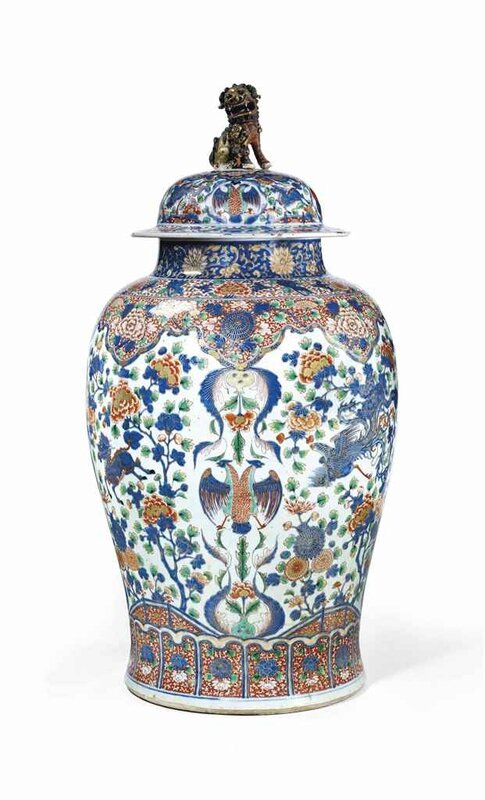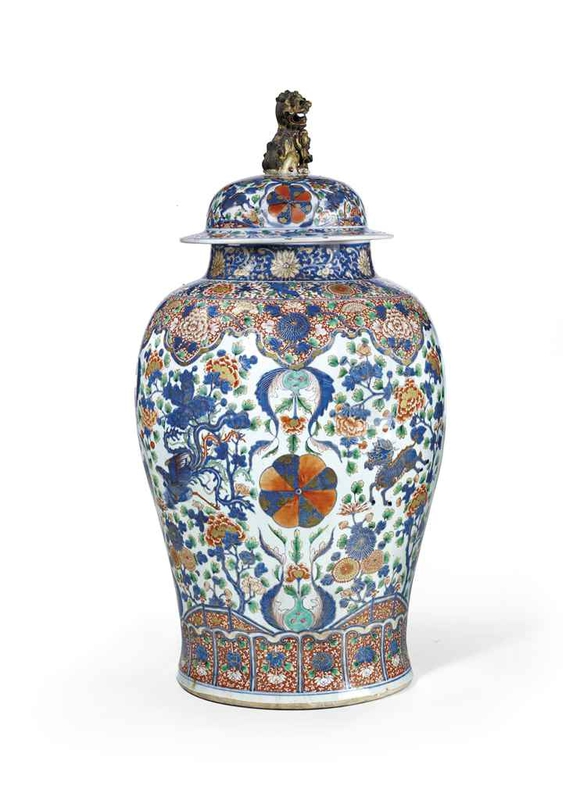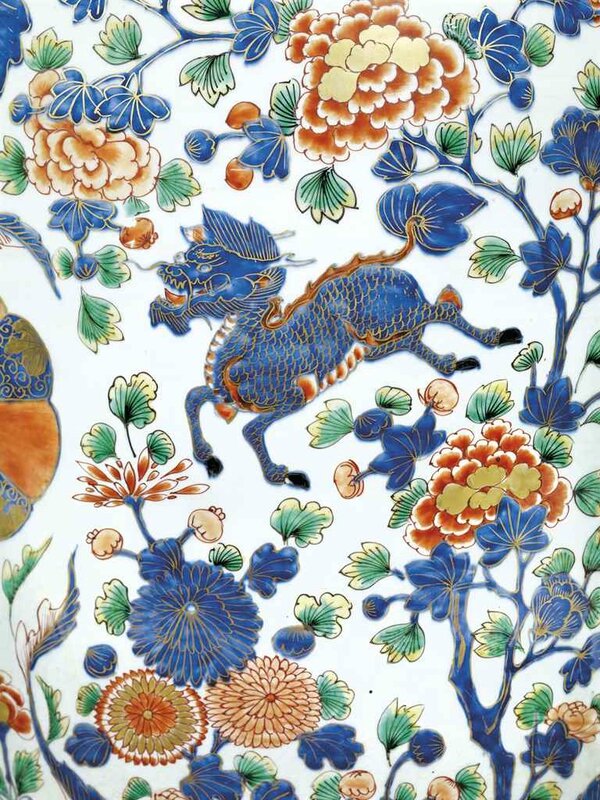Potiche couverte en porcelaine de la famille verte et imari, Chine, dynastie Qing, époque Kangxi (1662-1722)
Lot 83. Potiche couverte en porcelaine de la famille verte et imari, Chine, dynastie Qing, époque Kangxi (1662-1722). Estimate EUR 20,000 - EUR 30,000 (USD 21,372 - USD 32,058) © Christie’s Images Limited 2016.
La panse est harmonieusement décorée d'une aigle bicéphale se répétant à deux reprises en alternance avec un mon en forme de rosace pendant d'une grenade et d'une fleur de lotus épanouie, sur fond de rinceaux fleuris feuillagés abritant des oiseaux fabuleux à longue queue et des chimères, le tout rehaussé d'or. La prise du couvercle est en forme de lion bouddhique, restauration au couvercle. Hauteur : 95 cm. (37 ½ in.), socle
Provenance: Private collection from the South of France.
A large verte-imari double-headed eagle jar and cover, probably for the Mexican market, China, Qing dynasty, Kangxi period (1662-1722)
Note: The double-headed eagle, or Habsburg eagle, on this jar was the emblem used by The Order of St. Augustine, and they were most likely ordered for the Spanish or New Spain market. The Spanish Augustinians were established in Manila in the 15th century, and soon after in Macao, Mexico and India, during which time they made their first of several expeditions to China. Numerous Chinese porcelains made their way from the Spanish outpost in Manila to Acapulco during the great eras of the 'Manila galleon trade', defined by J. Mudge as 1573-1620, and again in the late 17th century (Chinese Export Porcelain in North America, New York, 1986, p. 71). Most of these porcelains were blue and white, but Mudge mentions approximately 18 armorial services made for the Mexican market that are represented in the Franz Mayer collection, Mexico City. See William R. Sargent, Chinese Porcelain in the Conde Collection, Mexico, 2014, no. Another covered jar, with same design but of smaller dimension was offered at Christie's New York, 20-21 January 2004, lot 307. Plates with the same design were sold at Christie’s London, 30 April 2015, lot 117 and Christie's New York, 21 January 2003, lot 280; William Sargent mentions that a shard of Imari-decorated Chinese porcelain with the double-headed eagle was found in the Zócalo, Mexico City. Nuno de Castro, in A porcelana chinesa ao tempo do Imperio - Chinese porcelain at the time of the Empire,Portugal/Brasil, 2007, illustrates on pp. 352-356 several examples of Chinese porcelain made for the Order of St. Augustine, ranging in date from circa 1595 to circa 1770, all of which display the Habsburg eagle.
Christie's. Art d'Asie, 14 December 2016, Paris

/https%3A%2F%2Fprofilepics.canalblog.com%2Fprofilepics%2F1%2F0%2F100183.jpg)
/https%3A%2F%2Fstorage.canalblog.com%2F03%2F02%2F119589%2F96711876_o.jpg)
/https%3A%2F%2Fstorage.canalblog.com%2F11%2F31%2F119589%2F94773502_o.jpg)
/https%3A%2F%2Fstorage.canalblog.com%2F20%2F83%2F119589%2F94772815_o.jpg)
/https%3A%2F%2Fstorage.canalblog.com%2F26%2F72%2F119589%2F75604929_o.jpg)
/https%3A%2F%2Fstorage.canalblog.com%2F59%2F60%2F119589%2F26458628_o.jpg)






/http%3A%2F%2Fstorage.canalblog.com%2F05%2F64%2F119589%2F128523518_o.jpg)
/http%3A%2F%2Fstorage.canalblog.com%2F78%2F46%2F119589%2F127133605_o.jpg)
/http%3A%2F%2Fstorage.canalblog.com%2F99%2F82%2F119589%2F126892955_o.jpg)
/http%3A%2F%2Fstorage.canalblog.com%2F51%2F84%2F119589%2F122518624_o.jpg)